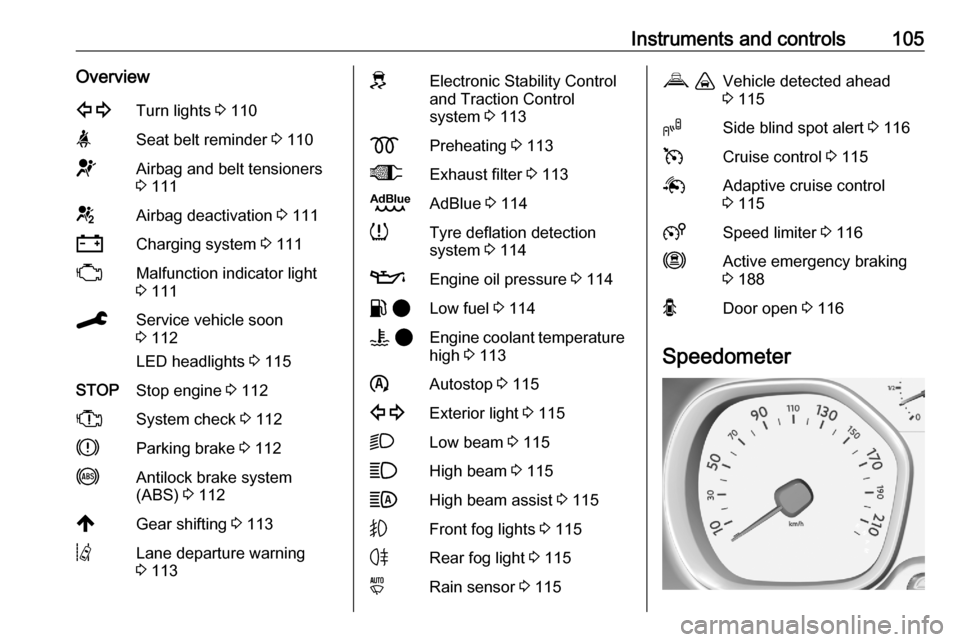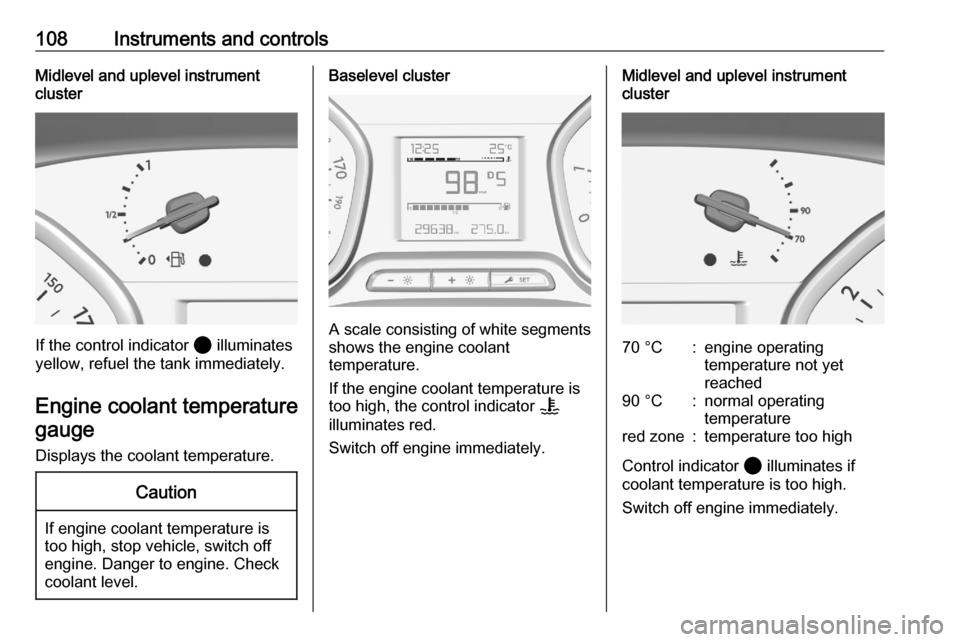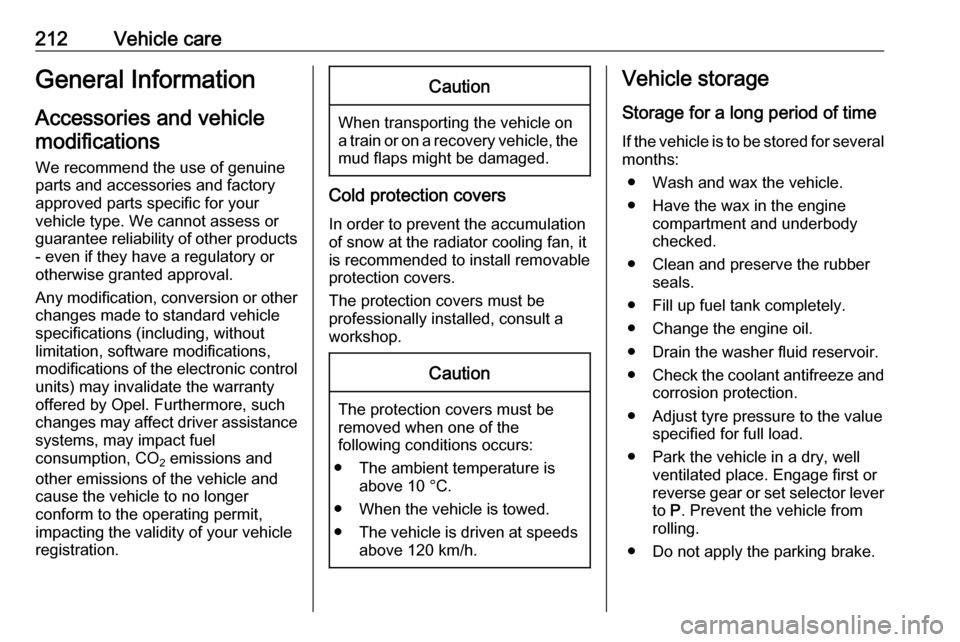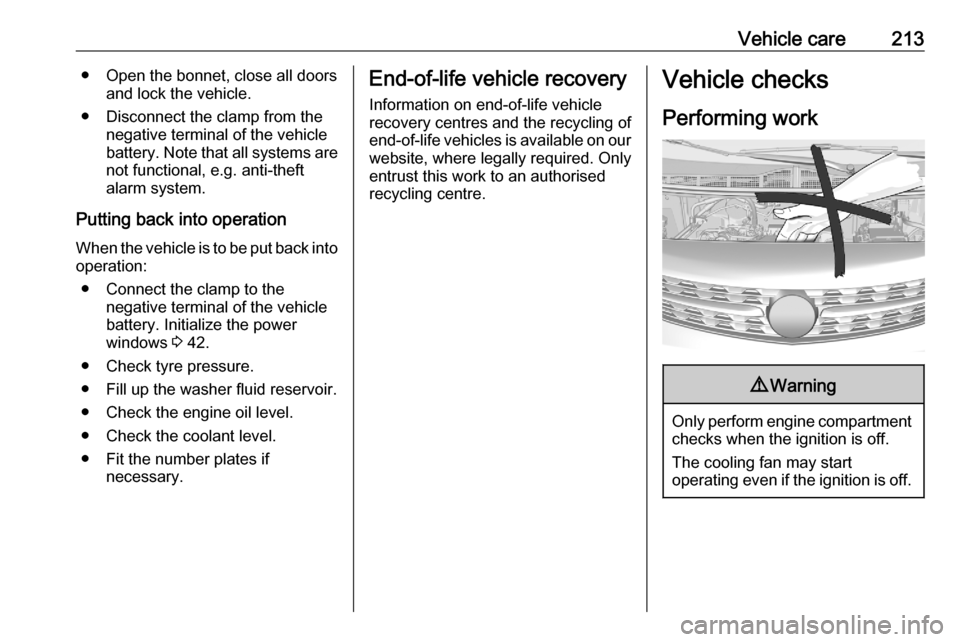engine coolant OPEL VIVARO C 2020.25 Manual user
[x] Cancel search | Manufacturer: OPEL, Model Year: 2020.25, Model line: VIVARO C, Model: OPEL VIVARO C 2020.25Pages: 287, PDF Size: 28.79 MB
Page 95 of 287

Instruments and controls93Instruments and
controlsControls ....................................... 94
Steering wheel adjustment ........94
Steering wheel controls .............94
Horn ........................................... 95
Steering column controls ...........95
Windscreen wiper and washer ..95
Rear window wiper and washer ...................................... 97
Outside temperature ..................97
Clock ......................................... 98
Power outlets ............................. 98
Warning lights, gauges and indi‐ cators ......................................... 101
Instrument cluster ....................101
Speedometer ........................... 105
Odometer ................................ 106
Trip odometer .......................... 106
Tachometer ............................. 107
Fuel gauge .............................. 107
Engine coolant temperature gauge ..................................... 108
Engine oil level monitor ...........109
Service display ........................ 109
Control indicators ....................110Turn lights................................ 110
Seat belt reminder ...................110
Airbag and belt tensioners .......111
Airbag deactivation ..................111
Charging system .....................111
Malfunction indicator light ........111
Service vehicle soon ...............112
Stop engine ............................. 112
System check .......................... 112
Brake system ........................... 112
Parking brake .......................... 112
Antilock brake system (ABS) ...112
Gear shifting ............................ 113
Lane departure warning ..........113
Electronic Stability Control and Traction Control system .........113
Engine coolant temperature ....113
Preheating ............................... 113
Exhaust filter ............................ 113
AdBlue ..................................... 114
Deflation detection system ......114
Engine oil pressure ..................114
Low fuel ................................... 114
Autostop .................................. 115
Exterior light ............................ 115
Low beam ................................ 115
High beam ............................... 115
High beam assist .....................115
LED headlights ........................ 115
Front fog lights ......................... 115Rear fog light........................... 115
Rain sensor ............................. 115
Cruise control .......................... 115
Adaptive cruise control ............115
Vehicle detected ahead ...........115
Side blind spot alert .................116
Active emergency braking .......116
Speed limiter ........................... 116
Door open ................................ 116
Displays ..................................... 116
Driver Information Centre ........116
Info Display .............................. 120
Head-up display ......................121
Vehicle messages ......................123
Warning chimes .......................123
Vehicle personalisation ..............124
Telematics services ...................128
Opel Connect .......................... 128
Page 107 of 287

Instruments and controls105Overview1Turn lights 3 110aSeat belt reminder 3 110dAirbag and belt tensioners
3 111eAirbag deactivation 3 111SCharging system 3 111WMalfunction indicator light
3 111CService vehicle soon
3 112
LED headlights 3 115STOPStop engine 3 112XSystem check 3 112hParking brake 3 112iAntilock brake system
(ABS) 3 112,Gear shifting 3 113QLane departure warning
3 113JElectronic Stability Control
and Traction Control
system 3 113zPreheating 3 113+Exhaust filter 3 113BAdBlue 3 114qTyre deflation detection
system 3 114TEngine oil pressure 3 114r 2Low fuel 3 114V 2Engine coolant temperature
high 3 113ñAutostop 3 1151Exterior light 3 115DLow beam 3 115AHigh beam 3 115BHigh beam assist 3 115GFront fog lights 3 115HRear fog light 3 115yRain sensor 3 115V ,Vehicle detected ahead
3 115,Side blind spot alert 3 116vCruise control 3 115QAdaptive cruise control
3 1155Speed limiter 3 116mActive emergency braking
3 188ODoor open 3 116
Speedometer
Page 110 of 287

108Instruments and controlsMidlevel and uplevel instrument
cluster
If the control indicator 2 illuminates
yellow, refuel the tank immediately.
Engine coolant temperature gauge
Displays the coolant temperature.
Caution
If engine coolant temperature is
too high, stop vehicle, switch off
engine. Danger to engine. Check
coolant level.
Baselevel cluster
A scale consisting of white segments
shows the engine coolant
temperature.
If the engine coolant temperature is
too high, the control indicator V
illuminates red.
Switch off engine immediately.
Midlevel and uplevel instrument
cluster70 °C:engine operating
temperature not yet
reached90 °C:normal operating
temperaturered zone:temperature too high
Control indicator 2 illuminates if
coolant temperature is too high.
Switch off engine immediately.
Page 115 of 287

Instruments and controls113Gear shifting
, with the number of a higher gear
is indicated, when upshifting is
recommended for fuel saving
reasons.
On some vehicles with manual
transmission, the system suggests to shift into neutral position, when the
activation of the stop-start system is
recommended.
Lane departure warning Q flashes green.
System recognises an unintended
lane change.
Lane departure warning 3 200.
Electronic Stability Control and Traction Control system
J illuminates or flashes yellow.Illuminates
A fault in the system is present.
Continued driving is possible. Driving
stability, however, may deteriorate depending on road surface
conditions.
Have the cause of the fault remedied
by a workshop.
Flashes
The system is actively engaged.
Engine output may be reduced and the vehicle may be braked
automatically to a small degree.
Electronic Stability Control and
Traction Control system 3 171.
Selective ride control 3 172.
Engine coolant temperature
V or 2 illuminates red.
Illuminates when the engine is
running
Stop, switch off engine.Caution
Coolant temperature too high.
Check coolant level immediately
3 215.
If there is sufficient coolant, consult a workshop.
Preheating
z illuminates yellow.
Preheating of diesel engine is
activated. Only activates when
outside temperature is low. Start the
engine when control indicator
extinguishes.
Exhaust filter
+ or C illuminates yellow,
accompanied by a message in the
Driver Information Centre and a
chime.
The exhaust filter requires cleaning.
Continue driving until the control
indicator extinguishes.
Page 160 of 287

158Driving and operatingWith touchscreen
The stop-start system can be
deactivated in the vehicle
personalisation 3 124.
If the system is deactivated during an Autostop, the engine restarts
immediately.
AutostopVehicles with manual transmission
An Autostop can be activated at a
standstill or at a speed below
20 km/h.
Activate an Autostop as follows: ● Depress the clutch pedal.
● Set the selector lever to neutral.
● Release the clutch pedal.
The engine will be switched off while the ignition stays on.Vehicles with automatic transmissionIf the vehicle is at a standstill with
depressed brake pedal or gear
selector in N, Autostop is activated
automatically.In case of vehicles with automatic
transmission of type B, an Autostop
can also be activated at a speed below 20 km/h.
The engine will be switched off while the ignition stays on.
Indication
An Autostop is indicated by control
indicator ñ.
During an Autostop, the heating and
brake performance will be
maintained.
Conditions for an Autostop
The stop-start system checks if each
of the following conditions is fulfilled.
● The stop-start system is not manually deactivated.
● The driver's door is closed or the driver's seat belt is fastened.
● The sliding doors are closed
● The vehicle battery is sufficiently charged and in good condition.
● The engine is warmed up.
● The ambient temperature is between 0 °C and 35 °C.
● The engine coolant temperature is not too high.
● The engine exhaust temperature is not too high, e.g. after driving
with high engine load.
● The climate control system allows an Autostop.
● The brake vacuum is sufficient.
● The self-cleaning function of the exhaust filter is not active.
● The vehicle was driven at least at
walking speed since the last
Autostop.
Otherwise an Autostop will be
inhibited.
Note
The Autostop may be inhibited for
several hours after a battery
replacement or reconnection.
Page 208 of 287

206Driving and operatingFor trailers with low driving stability
and caravan trailers, the use of an
oscillation damper is strongly
recommended.
If the trailer starts snaking, drive more slowly, do not attempt to correct the
steering and brake sharply if
necessary.
When driving downhill, drive in the
same gear as if driving uphill and
drive at a similar speed.
If the outside temperature exceeds
37 °C, reduce the load on the trailer
to protect the engine of the vehicle.
At high outside temperatures it is
recommended to leave the engine
running for one or two minutes after
having stopped the vehicle in order to
faciliate cooling.
Adjust tyre pressure to the value
specified for full load 3 271.
Towing a trailer increases the braking
distance of the vehicle. To limit the
heating of the brakes, it is
recommended to use the braking
effect of the engine.By driving uphill, the temperature of
the coolant is increased. To reduce
heating, drive at a reduced speed and
pay attention to the coolant
temperature. If the control indicator
2 of the engine coolant temperature
gauge illuminates, stop the vehicle
and switch off engine as soon as
possible.
Trailer towing Trailer loadsThe permissible trailer loads are
vehicle and engine-dependent
maximum values which must not be
exceeded. The actual trailer load is
the difference between the actual
gross weight of the trailer and the
actual coupling socket load with the
trailer coupled.
The permissible trailer loads are
specified in the vehicle documents. In general, they are valid for gradients
up to 12%.
The permissible trailer load applies
up to the specified incline and at sea
level. Since engine power decreases
as altitude increases due to the airbecoming thinner, therefore reducing
climbing ability, the permissible gross
train weight also decreases by 10%
for every 1000 metres of altitude. The gross train weight does not have to be
reduced when driving on roads with
slight inclines (less than 8%, e.g.
motorways).
The permissible gross train weight
must not be exceeded. This weight is
specified on the identification plate
3 264.
When distributing the loads in the trailer, heavy objects should be
placed as close as possible to the
axle.
Vertical coupling load
The vertical coupling load is the load
exerted by the trailer on the coupling
ball. It can be varied by changing the
weight distribution when loading the
trailer.
The maximum permissible vertical
coupling load is specified on the
towing equipment identification plate
and in the vehicle documents.
Page 213 of 287

Vehicle care211Vehicle careGeneral Information...................212
Accessories and vehicle modifications .......................... 212
Vehicle storage ........................212
End-of-life vehicle recovery .....213
Vehicle checks ........................... 213
Performing work ......................213
Bonnet ..................................... 214
Engine oil ................................. 214
Engine coolant ......................... 215
Washer fluid ............................ 216
Brakes ..................................... 216
Brake fluid ............................... 216
Vehicle battery ......................... 217
Diesel fuel system bleeding .....219
Wiper blade replacement ........219
Bulb replacement .......................220
Halogen headlights ..................220
Xenon headlights .....................223
Front fog lights ......................... 224
Front turn lights .......................225
Tail lights ................................. 226
Side turn lights ......................... 228
Centre high-mounted brake light ......................................... 229Number plate light...................230
Interior lights ............................ 230
Electrical system ........................231
Fuses ....................................... 231
Engine compartment fuse box . 232
Instrument panel fuse box .......232
Vehicle tools .............................. 234
Tools ........................................ 234
Wheels and tyres .......................237
Winter tyres ............................. 237
Tyre designations ....................237
Tyre pressure .......................... 237
Tyre deflation detection
system .................................... 238
Tread depth ............................. 239
Changing tyre and wheel size . 240
Wheel covers ........................... 240
Tyre chains .............................. 240
Tyre repair kit .......................... 241
Wheel changing .......................244
Spare wheel ............................ 245
Jump starting ............................. 250
Towing ....................................... 251
Towing the vehicle ...................251
Towing another vehicle ...........252
Appearance care .......................253
Exterior care ............................ 253Interior care............................. 255
Floor mats ............................... 256
Page 214 of 287

212Vehicle careGeneral Information
Accessories and vehicle modifications
We recommend the use of genuine
parts and accessories and factory
approved parts specific for your
vehicle type. We cannot assess or guarantee reliability of other products
- even if they have a regulatory or
otherwise granted approval.
Any modification, conversion or other changes made to standard vehicle
specifications (including, without
limitation, software modifications,
modifications of the electronic control units) may invalidate the warranty
offered by Opel. Furthermore, such
changes may affect driver assistance
systems, may impact fuel
consumption, CO 2 emissions and
other emissions of the vehicle and
cause the vehicle to no longer
conform to the operating permit,
impacting the validity of your vehicle
registration.Caution
When transporting the vehicle on
a train or on a recovery vehicle, the
mud flaps might be damaged.
Cold protection covers
In order to prevent the accumulation
of snow at the radiator cooling fan, it is recommended to install removable
protection covers.
The protection covers must be
professionally installed, consult a
workshop.
Caution
The protection covers must be removed when one of the
following conditions occurs:
● The ambient temperature is above 10 °C.
● When the vehicle is towed.
● The vehicle is driven at speeds
above 120 km/h.
Vehicle storage
Storage for a long period of time If the vehicle is to be stored for several months:
● Wash and wax the vehicle.
● Have the wax in the engine compartment and underbody
checked.
● Clean and preserve the rubber seals.
● Fill up fuel tank completely.
● Change the engine oil.
● Drain the washer fluid reservoir.
● Check the coolant antifreeze and
corrosion protection.
● Adjust tyre pressure to the value specified for full load.
● Park the vehicle in a dry, well ventilated place. Engage first or
reverse gear or set selector lever
to P. Prevent the vehicle from
rolling.
● Do not apply the parking brake.
Page 215 of 287

Vehicle care213● Open the bonnet, close all doorsand lock the vehicle.
● Disconnect the clamp from the negative terminal of the vehicle
battery. Note that all systems are
not functional, e.g. anti-theft
alarm system.
Putting back into operation
When the vehicle is to be put back into
operation:
● Connect the clamp to the negative terminal of the vehicle
battery. Initialize the power
windows 3 42.
● Check tyre pressure.
● Fill up the washer fluid reservoir.
● Check the engine oil level.
● Check the coolant level.
● Fit the number plates if necessary.End-of-life vehicle recovery
Information on end-of-life vehicle
recovery centres and the recycling of
end-of-life vehicles is available on our website, where legally required. Only
entrust this work to an authorised
recycling centre.Vehicle checks
Performing work9 Warning
Only perform engine compartment
checks when the ignition is off.
The cooling fan may start
operating even if the ignition is off.
Page 217 of 287

Vehicle care215
Different dipsticks are used
depending on engine variant.
Pull out the dipstick, wipe it clean,
reinsert it fully, pull out and read the
engine oil level.
When the engine oil level has
dropped to the MIN mark, top up the
engine oil.
We recommend the use of the same
grade of engine oil that was used at
last change.
The engine oil level must not exceed the MAX mark on the dipstick.
Caution
Overfilled engine oil must be
drained or suctioned out. If the oil exceeds the maximum level, do
not start the vehicle and contact a
workshop.
Capacities 3 270.
Fit the cap on straight and tighten it.
Engine coolant The factory filled coolant provides
freeze protection down to approx.
-37 °C.
Caution
Only use approved antifreeze.
Coolant and antifreeze 3 262.
Coolant level
Caution
Too low a coolant level can cause engine damage.